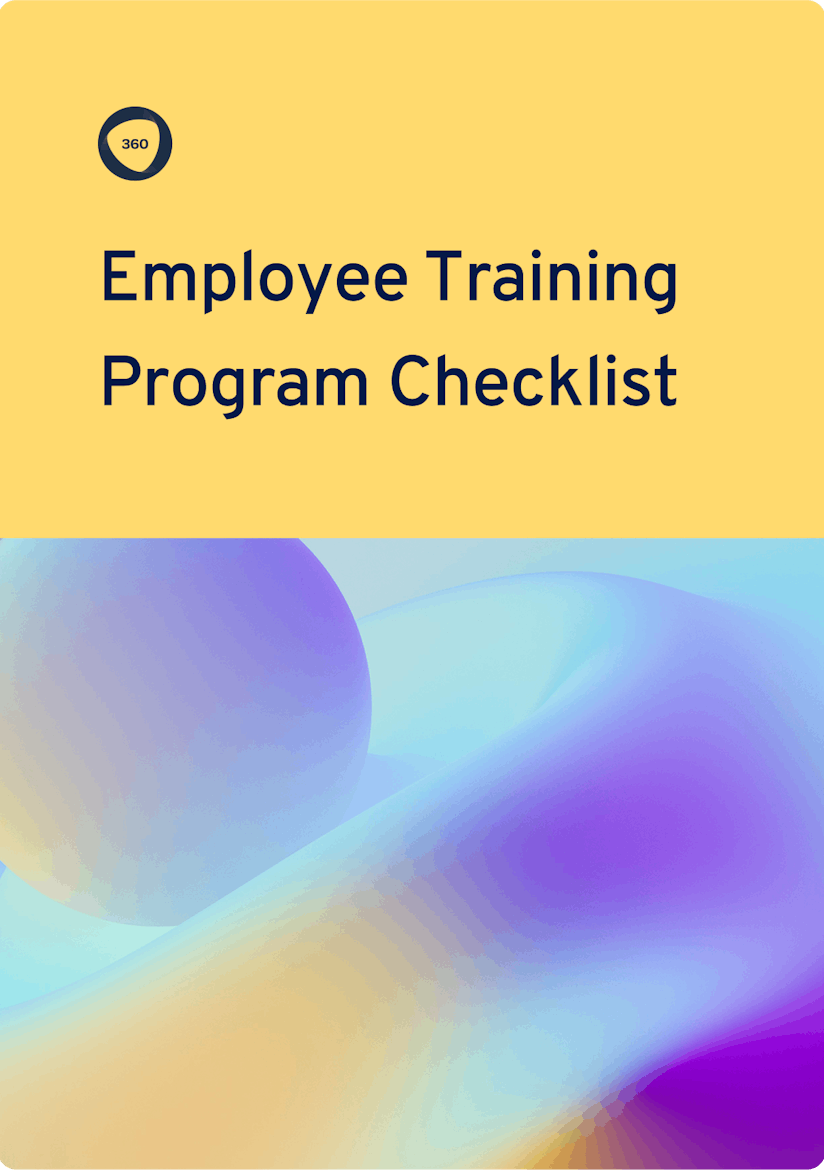
Discover the learning platform powered by collaborative learning.
A 15-minute discussion with an expert
100% tailored to your needs - with ❤️
No commitment. Free as can be.
Practical training manuals will significantly impact your organization, especially when onboarding new hires. 79% of employees say onboarding programs help them integrate and understand the company culture.
Not only do training manuals streamline your onboarding processes, but they also ensure that employees are performing while helping them access role-critical content when needed in the workflow.
So, let’s dive into the basics of training manuals, including the impacts on employee performance and company processes, seven steps to help you design an effective manual, and outline some common types of training manuals.

By providing your contact info, you agree to receive communications from 360Learning. You can opt-out at any time. For details, refer to our Privacy Policy.
Training manuals play a pivotal role as indispensable performance tools for optimizing the efficiency of employees in the flow of work.
Here are five quick impacts of implementing employee training manuals in your organization:
1. Standardization: A training manual keeps processes running smoothly and ensures efficiency. By ensuring all team members have the same training content from the get-go, your company can ensure everyone is on the same page with the same knowledge base.
2. Clarity and consistency: A well-structured training manual can effectively clarify daily tasks through to company policies in simple terms, making them clear, especially for beginners.
3. Onboarding: Essential in the employee onboarding process, which can be overwhelming, a training manual helps fast-track new hires into their new roles and company culture, making it a less stressful experience.
4. Reference tool: From the onboarding process onwards, an employee training manual will continue to impact performance and productivity as an easy reference tool for a quick refresh on a process or policy in the flow of work.
5. Knowledge retention: As L&D leaders, we know that learning isn’t a one-off process, but repetitive training sessions can also be resource-intensive. However, employees can refer to training manuals whenever they need to at no additional cost to the company, increasing their knowledge retention of the material.
Crafting a training manual requires a balance of comprehensive information and user-friendly presentation.
Let’s go through our step-by-step guide to writing an effective training manual:
When writing a manual, you should start by profiling the learners or employees leveraging the training guide.
The aim is to understand your learners’ needs, current experience, and challenges affecting performance and design the manual to target those pain points. For example, a manual for point-of-sale software would be very useful for a new hire working as a cashier in a supermarket. This training manual would be very different compared to one used by a new manager to learn about back office software.
Encourage your subject-matter experts to collaborate with the L&D team by providing insights or co-creating content.
Your organization’s internal experts have done the learning already and understand what it takes to perform at a high level in their roles. Your collaboration will help you create training content that is both comprehensive and relevant.
We recommend leveraging a learning platform with AI-powered expert recommendations and Academies that empower your internal experts to create effective training manuals at scale and share crucial institutional knowledge with their peers.
A clear structure for your training material will positively impact learners' engagement and boost retention.
Here's a simple outline of how your manual should be structured:
Employees may need to refer to their manual on the frontline, so prioritize readability when structuring and writing your employee handbook or training manual.
Leverage design principles like consistent fonts and clear imagery to ensure employee training material is easy to interact with. If you’re designing online courses, integrate video tutorials, referral links, or interactive infographics.
Use practical and realistic examples to guide your employees through their training manual.
A step-by-step guide through real-life scenarios or tasks that employees can expect in the flow of work can help make those complex tasks more approachable and straightforward. For example, an automated robot calibration procedure at a Ford factory would be easier to digest through steps with pictures rather than a full-page dissertation.
Include assessment tools throughout your training manual to test your desired outcomes.
These can be as simple as quizzes to help employees gauge their understanding and retention of the content. For example, a road code manual for a driver’s license tends to have multichoice questions following each section of the road code to test your understanding of each section before moving on.
Depending on what kind of information you include in your training manual, some may need to be updated more regularly than others due to compliance rules or legal obligations.
For example, be sure to keep your employee handbooks and performance aids updated with changing company policies, legal processes, regulations, or certification requirements.
You will need to ensure you pick the right tool for the right job. Various training manual types have emerged to address specific employee and organizational needs.
Look’s take a quick look at five different types of training manuals and their purposes:
1. Employee onboarding manuals: Designed for new hires, employee onboarding manuals introduce them to the organization, including company policies, team members, and company culture. They may also include checklists.
2. Technical training manuals: These are for roles that require knowledge of new software or technical processes. Impactful technical guides will include screenshots, infographics, and video tutorials of the products or processes they are involved with.
3. Employee handbook: An excellent performance aid for all team members, the trusty employee handbook provides new and seasoned employees alike with quick references to the day-to-day ins and outs of the company.
4. Role-specific manuals: These training guides are specific to job roles within the organization, such as sales or IT, and are tailored to address specific tasks and challenges of each role.
5. Interactive online training manuals: Designed for digital learning, online training manuals leverage elements from online courses. Some include gamification elements, such as quizzes and interactive videos, to convey complex ideas in a digestible way.
We recommend that you leverage some of these 23 Employee Training Templates and Checklists for Better Training Programs to help you get started on developing your training manuals.
A 15-minute discussion with an expert
100% tailored to your needs - with ❤️
No commitment. Free as can be.
By providing your contact info, you agree to receive communications from 360Learning. You can opt-out at any time. For details, refer to our Privacy Policy.
Training manuals can significantly impact the learning process and outcomes for new employees, strengthen the onboarding experience, and serve as performance aids in the flow of work.
You can further elevate the measurable impact of your training manuals using a comprehensive learning management system.
For example, 360Learning is a learning platform that fosters internal mobility to solve the talent shortage by empowering your employees to upskill from within the organization. With collaborative learning, you can turn your internal experts into champions for employee, customer, and partner growth.
Leveraged together, a learning platform and training manuals can truly boost your employees’ performance, learning strategy, and organizational goals. See how 360Learning can help you achieve these goals today.